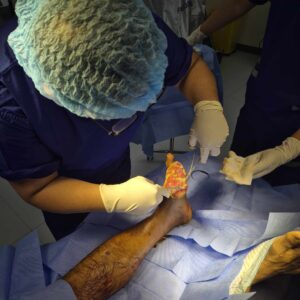Ankle and foot injuries are more common than many people realize. Whether caused by a sports incident, daily overuse, or something as simple as poor footwear, these injuries can significantly affect mobility, stability, and quality of life. Recognizing the signs early and understanding the treatment options available is key to recovery. This guide explores ankle and foot injury treatment in detail, including causes, symptoms, diagnosis, and both short-term and long-term solutions.
Common Causes of Ankle and Foot Injuries
There are several reasons people experience ankle and foot injuries. The foot and ankle are complex structures made up of bones, ligaments, muscles, tendons, and joints, all of which work in unison to support movement and maintain balance. When any part of this system is compromised, pain and injury may occur.
1. Sports and Physical Activities High-impact activities, running, jumping, or abrupt directional changes can cause strains, sprains, or fractures. Athletes are especially prone to these injuries due to the high level of stress placed on the lower extremities.
2. Poor Footwear Wearing shoes without adequate arch support, cushioning, or grip can contribute to imbalances, increased pressure on certain areas, and eventual injury. Heels and overly flat shoes are common culprits.
3. Overuse and Repetitive Motion Daily activities or occupations that require prolonged standing, walking, or repeated foot movements can lead to overuse injuries like shin splints, tendinitis, or plantar fasciitis.
4. Accidents and Trauma Tripping, falling, or twisting the ankle unexpectedly can lead to acute injuries. This includes ligament sprains, bone fractures, or tendon tears.
5. Underlying Conditions Certain conditions, such as arthritis, flat feet, or diabetes, can increase susceptibility to foot and ankle injuries due to reduced joint function, poor circulation, or nerve damage.
Symptoms to Watch Out For
Identifying symptoms early can prevent a minor issue from becoming a chronic problem. Key symptoms that may indicate the need for ankle and foot injury treatment include:
- Persistent pain while walking or at rest
- Swelling, bruising, or visible deformity
- Difficulty bearing weight or instability
- Stiffness or reduced range of motion
- Numbness or tingling, especially if accompanied by weakness
Ignoring these symptoms can lead to further complications and delay recovery. Any pain that lasts more than a few days, especially after an injury, warrants professional attention.
Diagnosis and When to See a Specialist
Diagnosing the cause of foot or ankle pain often involves a detailed medical history, physical examination, and sometimes imaging tests.
- Physical Examination: A healthcare provider will assess your foot and ankle alignment, flexibility, and strength.
- X-ray or MRI: These imaging tests help determine the extent of bone damage or soft tissue injury.
- Gait Analysis: This can identify issues in your walking pattern that might be contributing to the injury or are the result of it.
If your symptoms interfere with daily activities or don’t improve with rest and home care, it’s best to consult a podiatrist or orthopedic specialist.
Effective Treatment Options
Ankle and foot injury treatment depends on the severity and type of injury. While mild cases may resolve with conservative measures, more serious injuries might require advanced interventions.
1. R.I.C.E. Method (Rest, Ice, Compression, Elevation) This initial approach is helpful for reducing swelling and relieving pain:
- Rest: Avoid putting weight on the injured area.
- Ice: Apply cold packs for 15-20 minutes every few hours.
- Compression: Use an elastic bandage to minimize swelling.
- Elevation: Keep the foot raised above heart level.
2. Medications Over-the-counter anti-inflammatory drugs such as ibuprofen can help reduce pain and swelling.
3. Physical Therapy Rehabilitation exercises strengthen the surrounding muscles, restore flexibility, and improve joint stability. A physical therapist may use techniques such as stretching, strengthening exercises, and balance training.
4. Orthotics and Support Devices Custom shoe inserts or braces can correct alignment issues, provide support, and relieve pressure on affected areas. These are especially useful in preventing recurring injuries.
5. Surgery For severe injuries like torn ligaments or fractures that do not heal properly with conservative treatment, surgical intervention may be necessary. Recovery can include a period of immobilization followed by physical therapy.
Preventive Measures
Preventing ankle and foot injuries involves being proactive about foot health. Some effective strategies include:
- Choose Proper Footwear: Wear shoes suited for your activity that provide proper arch support, cushioning, and stability.
- Warm-Up and Stretch: Prepare your muscles before engaging in physical activity.
- Build Strength and Flexibility: Incorporate exercises that enhance ankle and foot strength and flexibility.
- Manage Chronic Conditions: Keep health issues like diabetes or arthritis under control with proper medical care.
- Take Rest Days: Avoid overuse by giving your feet time to recover, especially after intense activity.
Importance of Proper Recovery and Follow-Up
Recovery doesn’t end once the pain subsides. Ensuring full healing is essential to preventing future problems.
- Gradual Return to Activity: Slowly reintroduce movement and activity to avoid reinjury.
- Monitor Healing Progress: Regular follow-ups with your healthcare provider help confirm that recovery is on track.
- Reinforce Good Habits: Continue wearing supportive footwear and doing strength-building exercises.
Incomplete recovery or returning to activities too soon can lead to chronic pain, joint instability, or compensatory injuries elsewhere in the body.
Takeaway
Ankle and foot injury treatment should never be overlooked. Whether the pain results from poor footwear, overuse, or a specific injury, addressing it early can prevent long-term damage and help restore mobility. From conservative methods like the R.I.C.E. protocol to professional interventions such as physical therapy or orthotics, there are numerous ways to manage and treat these issues effectively. Ensuring proper diagnosis, adhering to a tailored treatment plan, and committing to preventive care will significantly reduce the risk of future injury and keep you on your feet with confidence.






